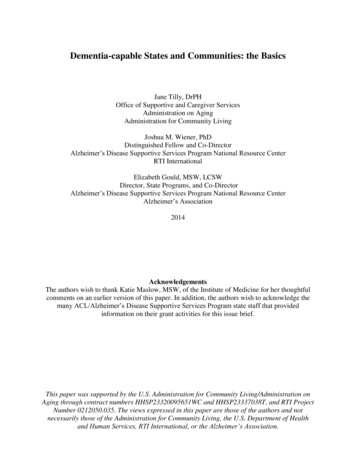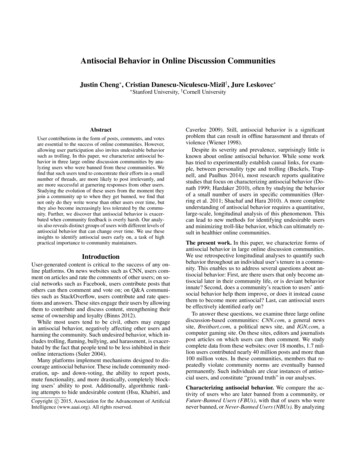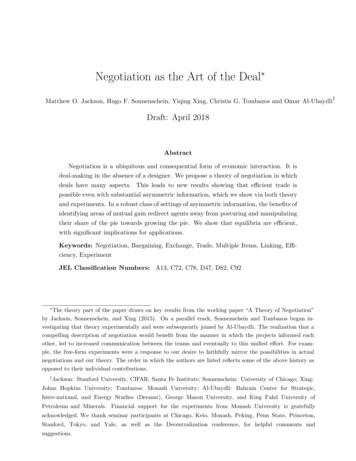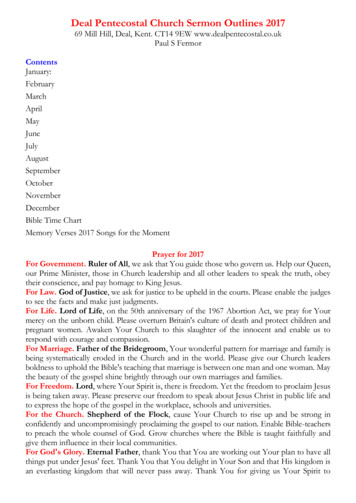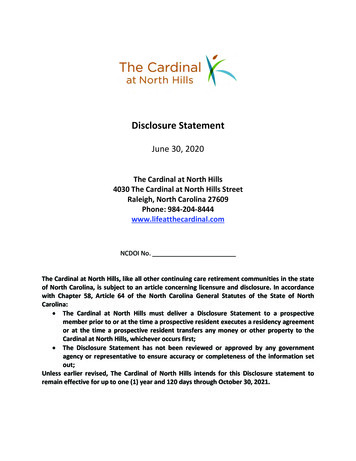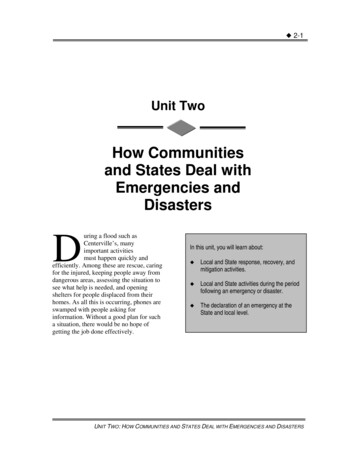
Transcription
X 2-1Unit TwoHow Communitiesand States Deal withEmergencies andDisastersuring a flood such asCenterville’s, manyimportant activitiesmust happen quickly andefficiently. Among these are rescue, caringfor the injured, keeping people away fromdangerous areas, assessing the situation tosee what help is needed, and openingshelters for people displaced from theirhomes. As all this is occurring, phones areswamped with people asking forinformation. Without a good plan for sucha situation, there would be no hope ofgetting the job done effectively.DIn this unit, you will learn about:XLocal and State response, recovery, andmitigation activities.XLocal and State activities during the periodfollowing an emergency or disaster.XThe declaration of an emergency at theState and local level.UNIT TWO: HOW COMMUNITIES AND STATES DEAL WITH EMERGENCIES AND DISASTERS
X 2-2Fortunately, many local areas and States have developed emergency operations plans thathelp them respond and recover effectively. Their roles, as well as those of voluntary agencieswhose invaluable efforts supplement theirs, are defined in these plans. When an emergency ordisaster occurs, these plans are put into action to provide essential services to the community.The following information explains the types of activities performed by local government,State government, and voluntary agencies to deliver this assistance.LOCAL RESPONSE AND RECOVERY ACTIVITIESLocal governments are the first line of defense against emergencies and disasters and areprimarily responsible for managing the response to and recovery from those events. At thelocal government level, the primary responsibility for protecting citizens belongs to localelected officials such as mayors, city councils, and boards of commissioners. When a localgovernment receives warning that an emergency could be imminent, its first priority is toalert and warn citizens and take whatever actions are needed to minimize damage and protectlife and property. If necessary, it may order an evacuation. When an emergency or disasterdoes occur, fire and police units,emergency medical personnel,and rescue workers rush todamaged areas to provide aid.After this initial response, thelocal government must work toensure public order and security.Vital services such as water,power, communications,transportation, shelter, andmedical care must be provided,and debris removal must begin.Since disasters often disrupt water supply lines, localPublic and private utilitygovernments must ensure that residents receive drinking water.company crews, along with otheremergency teams, must be on the job to restore essential services. The local governmentcoordinates its efforts with voluntary agencies who assist individuals and families inneed.A CITIZEN’S GUIDE TO DISASTER ASSISTANCE
X 2-3When a local government responds to and recovers from a disaster, the levels of activitiesand the type of resources required are determined by several factors:XThe speed of onset of the emergency.XThe potential need for evacuation.XThe magnitude of the situation.XThe projected duration of the event.XThe extent of the threat to citizens.Short-Term and Long-Term RecoveryIn the aftermath of an emergency or disaster, many citizens will have specific needs thatmust be met before they can return to their pre-disaster lives. Typically, there will be a needfor services such as these:XAssessment of the extent and severity of damages to homes and other property.XRestoration of services generally available in communities—water, food, andmedical assistance.XRepair of damaged homes and property.XProfessional counseling when the sudden changes resulting from the emergencyhave resulted in mental anguish and the inability to cope.Local governments help individuals and families recover by ensuring that these services areavailable and by seeking additional resources if the community needs them. Also, when anemergency occurs, the local government uses all available media to publicize the types ofassistance available and how to access them.UNIT TWO: HOW COMMUNITIES AND STATES DEAL WITH EMERGENCIES AND DISASTERS
X 2-4Recovery occurs in two phases—short-term and long-term. Short-term recovery measuresare those that are intended to return the community to minimum operating standards. Longterm recovery are those steps taken to return to previous conditions (to the extent possible),combined with improvements that will betterprotect the community from future disasters.Each phase marks a transition that will enablethe community to return to normal and create asafer condition for the future.Short-term recovery could include makinghouses habitable so that families can move outof temporary shelters and return to their ownhomes. Short-term recovery also could involverestoring essential services so people can returnto work. At the community level, this part ofrecovery may require completing repairs toroads and bridges so traffic can start movingagain or restoring water and power to areas inneed, especially to important public structuresFollowing a disaster, repairing majorroads is a high priority among short-termsuch as hospitals and major places ofrecovery tasks.employment. In Centerville, for example, shortterm recovery would include all of theseactivities, with priority given to restoring services in public structures and major places ofemployment. The restoration of major roads will be given priority to help people return totheir homes and work safely; many minor routes may have to wait for repairs.Long-term recovery may occur over a period of months or years, depending on the severityof the emergency or disaster. It often involves extensive repair and rebuilding. Thedisruption and destruction to the community can be so great that some businesses may neverreopen or may have to relocate. Although a community may appear to be “open forbusiness” a few weeks after an emergency or disaster, it may be years after a severe disasterbefore the community returns to pre-disaster conditions.A CITIZEN’S GUIDE TO DISASTER ASSISTANCE
X 2-5As part of the recovery, communities should consider strategies that would lessen the effectsof a similar event in the future. These strategies, called mitigation measures, may have helpedlessen the effects in the Centerville flood scenario. During the rebuilding process, residentscould raise their furnaces to higher floors, business owners could consider storing inventoryin areas above the flood level, and hospitals could elevate and move generators and othercritical facilities to protected buildings. In the case of severe and repeated flood damage,residents might consider relocating damaged structures to a safer area. The community ofCenterville could begin enforcing more stringent building codes and floodplain ordinancesthat help structures withstand flooding.In addition to the self-help efforts of individuals and families and the efforts of localgovernments in emergencies, voluntary agencies are a central part of the effective responseto, and recovery from, an emergency.The Role of Voluntary AgenciesWhen most Americans think about disasters, they picture volunteers from agencies such asthe American Red Cross and the Salvation Army providing a helping hand to the victims.Voluntary agencies are an essential part of any disaster relief effort, providing criticalassistance with food, shelter, clothing, household items, medical expenses, clean-up, repairs,and rebuilding. These agencies are typically involved in all the phases of emergencymanagement (mitigation, preparedness, response, and recovery).Some voluntary agencies are available to assist in emergencies in all communities; othersmay assist only in disasters that affect specific regional areas. Voluntary agencies assistwhether or not there is a Presidential declaration, coordinating with each other and withgovernment officials to meet a community’s disaster needs.UNIT TWO: HOW COMMUNITIES AND STATES DEAL WITH EMERGENCIES AND DISASTERS
X 2-6See Appendix B, page B-1,for a list of voluntaryagencies that are active indisasters and the servicesthey provide.Requesting StateAssistanceIf the situation warrants, thecommunity may have to reachbeyond its own boundaries forIn a flood such as Centerville’s, the State might be askedadditional resources. Mutualto help rescue stranded people and farm animals.aid agreements should alreadybe in place to facilitateprovision of assistance by neighboring jurisdictions. In our flood scenario, however, theseagreements will not result in significant added resources because other communities are alsooverwhelmed.In such a case, the local government would have to appeal to the State for assistance.Centerville would seek assistance in transportation and rescue, for example. Local officialswill submit a request to the Governor providing specific information about the situation andits effects and specifying the type of assistance needed. The State emergency managementoffice and other offices involved in providing disaster assistance carefully assess this requestand advise the Governor on appropriate actions.Periodically, local officials send reports to the State that convey important information aboutthe types and levels of assistance that might be required to assist the people in the impactedarea. A typical situation report would contain information about the magnitude and severityof damages associated with the disaster event. Deaths, injuries, property damages, andlocations in which losses occurred would be described. As additional information becomesavailable, updated reports are provided.A CITIZEN’S GUIDE TO DISASTER ASSISTANCE
X 2-7Generally, State emergency officials work very closely with local officials to ensure thatrequired documentation is included in situation reports. If a request were to be madesubsequently for a Presidential declaration (as will be explained in a later unit), theinformation contained in these reports would be of critical importance. The documentationof the local government’s level of effort in responding to the event and the location of areasof damage are especially important.STATE RESPONSE AND RECOVERY ACTIVITIESAll states have laws that describe the responsibilities of State government inemergencies and disasters. These laws provide governors and State agencieswith the authority to plan for and carry out the necessary actions to respond toemergencies and recover from their effects. Typically, State emergencymanagement legislation describes the duties and powers of the Governor, whoseauthority typically includes the power to declare a state of emergency and todecide when to terminate this declaration.Many of the specific responsibilities to carry out the provisions of the State emergencymanagement legislation are generally delegated to the State emergency managementorganization. Virtually all States have emergency management organizations, although theirname and structure may vary from State to State. Typical names include office of emergencyservices or division of emergency management. Regardless of the title or location of theemergency management organization in the structure of the State government, itsresponsibilities are the same—to prepare for emergencies and to coordinate the activationand use of the resources controlled by the State government when they are needed to helplocal governments respond to, and recover from, emergencies and disasters.The State emergency management organization, in its coordinating role, is involved invirtually all serious emergencies or disasters. Typically, this organization is responsible forreceiving reports from the local area. Based on these and other data, emergency managementofficials work in consultation with other agency representatives and members of theUNIT TWO: HOW COMMUNITIES AND STATES DEAL WITH EMERGENCIES AND DISASTERS
X 2-8Governor’s staff to determine whattypes of resources and personnelshould be deployed to the impactedarea. Using procedures specified inthe State plan, the State emergencymanagement organization willcoordinate deployment of Statepersonnel and resources to theimpacted areas.However, it is not necessary for aGovernor to declare an emergency orA Governor may declare a State emergency in order todisaster before agency personnel andfacilitate the deployment of State resources to aresources are deployed to monitordisaster area.situations and provide information.Personnel and equipment are typically used to monitor situations in which an area’s watersupply may become contaminated or when large-scale chemical leakage is possible. Stateagency personnel would generally be involved in early inspection activities and in makingreports back to the emergency management office and their own agencies for the purpose ofdetermining additional assistance that may be needed.When an emergency is declared, the Governor (or emergency management agency officialacting for the Governor) can mobilize resources to supplement their own supplies,equipment, and personnel. In a situation like that of Centerville, for example, in which largepopulated areas are threatened by the continued rise in floodwaters, the State could assist inevacuation of the threatened area by prescribing evacuation routes and helping to controlentries and departures from the disaster area.State and local government also may regulate the movement of persons inside the affectedarea; persons can be prevented from returning to buildings rendered uninhabitable or unsafeby the disaster itself. The exercise of these powers could become necessary not only toprotect the residents of the affected community but also to make the work of the emergencyresponse personnel safer and more efficient.A CITIZEN’S GUIDE TO DISASTER ASSISTANCE
X 2-9In many States, governors can suspend State laws or local ordinances if it isdetermined that the law in question willrestrict or prohibit efforts to relievehuman suffering caused by thesituation. In some States, after a Stateemergency declaration, the Governormay establish economic control overresources and services such as food,wages, clothing, and shelter in theaffected area.Under a State emergency declaration,governors typically are empowered tomobilize the National Guard and directits efforts. Generally, they are grantedthe power to use all available StateUnder a State emergency declaration, Governors typicallyresources needed to respond effectivelyare empowered to mobilize the National Guard and directand efficiently to the event. Theits efforts.Governor is able to draw upon theresources, expertise, and knowledge ofState agencies as needed to assist in the effort. In many disasters, the States can providetechnical assistance and resources that would not be available to most local officials withintheir own communities.An affected State also is able to request mutual aid from other States. Participating Statesagree to provide personnel, equipment, and supplies to another State in need through theEmergency Management Assistance Compact (EMAC) or a similar arrangement. Mutual aidenables States to draw upon a common pool of resources with minimal Federal involvement.Under a State emergency declaration, the Governor may also have the power to use orcommandeer private property for the purpose of responding to the disaster. Emergencymanagement acts generally grant the Governor the power to use, or authorize the use of,contingency and emergency funds in the event of an emergency. In some States, theGovernor also may reallocate funds when designated funds are exhausted.UNIT TWO: HOW COMMUNITIES AND STATES DEAL WITH EMERGENCIES AND DISASTERS
X 2-10Types of Assistance ProvidedTypically, there are two types of State response and recovery assistance.State personnel and resources can be activated and deployed to assist in the response andrecovery effort directly (or to manage it, in some instances).XExamples of this type of activity includeevacuation management, securing the affectedarea, and search and rescue.State personnel and equipment can bedeployed to perform a variety of monitoringand inspection activities that can ensure thesafety of inhabitants and response personnel inthe area.XState officials may inspect structuressuch as dams, levees, and bridges todetermine whether repairs are needed.Examples of these types of activities includethe use of officials to monitor threats ofchemical and other fires or to monitor thewater supply and ensure its continued safety.State officials may periodically inspectstructures such as dams, levees, and bridges tomonitor their condition and determine whetherthey are safe for continued use.If necessary, the State may undertake emergency repairs (such as to restore bridges that are partof an essential route).A CITIZEN’S GUIDE TO DISASTER ASSISTANCE
X 2-11State assistance to communitiesis provided by many differentState agencies. Some keyagencies and types of servicesthey provide are describedbelow.Department of PublicSafetyIn many major floods—such asState public safety officials may assist in search and rescuethe one depicted in theoperations.scenario—bridges often aredamaged, and very heavy debrismay clog up the river, creating a more serious threat to surrounding areas. Heavy cranes andother equipment, along with the expertise and skill needed to use the equipment, can often beprovided by State transportation or highway agencies. Engineers employed by transportationdepartments also have the knowledge and skills to conduct accurate damage assessments ofbridges and other structures. In addition, they can suggest mitigation methods so thatreconstruction includes added protection for future disasters.State public safety personnel can assist in law enforcement for disaster areas, traffic control(especially in evacuation and for incoming assistance), security (such as to protect evacuatedhomes and businesses from looting and further damage), and search and rescue. The firemarshal’s office can deploy personnel to investigate structural fires and to assist in assessingthe safety of structures that may be at risk from fires.Public health units within the public safety department often must perform tasks such aswater supply monitoring, food supply inspection, and communicable disease control. Statespecialists also may assist in documenting (videotaping) damage.UNIT TWO: HOW COMMUNITIES AND STATES DEAL WITH EMERGENCIES AND DISASTERS
X 2-12Social Service AgenciesState social service agencies can provide or fund personnel and resources to assist in themanagement of shelters and to provide assistance to individuals and families. This caninclude counseling to alleviate stress, which, experience has demonstrated, must be handledappropriately in the early phases of a disaster to minimize later negative effects of theexperience. If there is a Presidential declaration, these are usually the agencies that provideadministrative services to manage the Individuals and Households Program. These agenciesalso are usually assigned to assist voluntary agencies such as the American Red Cross intheir efforts to provide relief to disaster victims.The National GuardIn a flood as serious as the one described in the scenario, the State National Guard couldsend personnel who could be assigned a wide range of duties. They would assist in floodfighting activities such as sandbagging, evacuation, and search and rescue. The NationalGuard is frequently assigned to maintain order and civil control and to provide supplementallaw enforcement and fire suppression assistance.The National Guard units also have other valuable resources and equipment that can beused: trucks, helicopters, heavy tools and equipment, portable medical facilities, mobilekitchens, and communications equipment.Public Health AgenciesState public health agencies perform several important functions in response and recovery.These agencies can make available: physicians, nurses, epidemiologists, medicaltechnicians, and others. Equipment and facilities also are provided.A CITIZEN’S GUIDE TO DISASTER ASSISTANCE
X 2-13Monitoring water supplies,inspecting food supplies,controlling communicablediseases, providing andallocating medication indisaster-impacted areas,monitoring health carefacilities, and identifyingvictims are among the moreimportant response andshort-term recovery activitiesthat can be provided by, orcoordinated through, Statepublic health agencies.State natural resource agencies may be able to contributeexpertise when natural resources are threatened by fire.Department of AgricultureThe State’s department of agriculture will generally assist when damage to farms and ranchesis involved. It often carries out measures to protect the long-term food supply of the affectedarea. State agriculture departments also inventory food resources and may help procure foodfor disaster victims. Longer term assistance provided by agriculture departments includesadvising farmers and agribusinesses in mitigation planning and recovering from damages tofacilities, crops, and livestock.Natural Resource AgenciesNatural resource agencies have several types of expertise useful to an effective response,including fire suppression and the protection of fish and game resources. Natural resourceagencies may have personnel available to assist in conducting damage assessments. Also,these agencies advise local officials and help them monitor and protect natural resources suchas fish and game, as well as wildlands and other protected areas. Environmental protectionagencies may assist in similar ways to help local officials preserve and protect variousenvironmentally sensitive areas and to plan mitigation measures for further disasters.UNIT TWO: HOW COMMUNITIES AND STATES DEAL WITH EMERGENCIES AND DISASTERS
X 2-14They can also provide technical expertise to help agencies respond appropriately to hazardousmaterials spills that could result from primary events such as floods.Other ResourcesOther State agencies have resources and expertise helpful to local communities stricken bydisaster. For example, labor departments can assist with immediate safety inspections.Education departments can help maintain education services. State management and budgetagencies can assist in locating and establishing recovery centers and field operations offices.Depending upon the severity of the disaster and the damages, some agencies— such as officesof management and budget, labor, employment security, commerce, and treasury—becomemore substantially involved in providing assistance for the community’s recovery. Forexample, treasury departments can conduct post-emergency audits to document expendituresby local governments. In some States, they also provide tax advice for disaster victims.Some State general services agencies can help identify and make available State facilities andrelated equipment to be used for shelter, as well as for the warehousing of food supplies orother resources.In most States, commerce departments assist in licensing motor carriers and other vehiclesneeded to transport supplies. They also work to expedite and prioritize the recovery of utilitiesto the affected areas. Personnel from these agencies also may be involved in damageassessment work.Finally, a key activity of State emergency offices is to review and critique the State’s effort,with the objective of strengthening the State’s response in the event of another disaster.A CITIZEN’S GUIDE TO DISASTER ASSISTANCE
X 2-15Requesting Federal AssistanceWhat if the available resources and personnel of both the local and State governments areinadequate to meet the response and recovery needs created by the disaster? The localgovernment or State officials may at any time request assistance directly from a number ofFederal agencies, most of which can provide some form of direct assistance without aPresidential declaration. When a disaster situation is beyond the capabilities of local and Stateresources, even as supplemented by private and voluntary agencies and by direct assistancefrom Federal agencies, the Governor may ask the President to declare a major disaster. Ifgranted, supplemental disaster assistance is made available to help individuals, families, andthe community.THE ROLE OF PLANNING IN DISASTER ASSISTANCEThe ability of communities and States toeffectively respond and recover fromdisasters depends largely on actions takenbefore the disaster. Communities andStates should develop response, recovery,and hazard mitigation plans. Officials planwhat roles different organizations wouldhave in a disaster and how they wouldcoordinate with each other to avoidduplication of benefits or confusion.Response PlanningTERM TO REMEMBEREmergency Operations PlanorEmergency Response PlanA document that contains informationon the actions that may be taken by agovernmental jurisdiction to protectpeople and property before, during, andafter a disasterThe community’s ability to respond to anemergency begins with the development of a local emergency operations plan.Each community’s plan may include a list of resources the community would use for varioustypes of emergencies. In a flood such as Centerville’s, for example, the local governmentwill contact technical experts who can assess the condition of the flood protection structuresand analyze the implications of their condition for flood control. The community’sUNIT TWO: HOW COMMUNITIES AND STATES DEAL WITH EMERGENCIES AND DISASTERS
X 2-16advance planning should also identify what routes could be used to evacuate people quicklyin the event of a disaster. In Centerville’s case, since the area has always been vulnerable toflooding, these would be pre-selected to facilitate movement. Shelter locations would also beidentified as a preparedness measure.The plan also establishes ways to notify the public in the event of an emergency. In ourscenario, electric power was lost in Centerville, so many people could not get informationeither by phone or by television. The area did not have a siren warning system, andevacuation routes were not generally familiar to the public. As a result, the only means ofreaching many people was through broadcasts that could be received only on battery-operatedradios or by traveling to their neighborhoods.Where did Centerville get the boats it usedto rescue its citizens? Unless the town hadworked out an advance agreement withpossible sources, it lost valuable time tryingto make the necessary arrangements at thetime of immediate need. In addition tomaking arrangements with private sourcesto borrow resources (such as heavyequipment that may be needed for debrisremoval), communities may also havemutual aid agreements in place withadjacent communities to facilitate requestsfor assistance.In addition to providing policies,procedures, and an emergency organizationstructure, the plan contains information onthe specific emergency conditions underwhich the plan will be activated. If theCommunity plans should specify sources for theconditions warrant, local authorities mayheavy equipment needed for debris removal.declare an emergency. The legal basis for alocal state-of-emergency declarationtypically is a local ordinance that stipulates who has the authority to declare a state ofemergency and under what conditions this can be done. Documentation provided in the plangives local governments a solid legal foundation for any subsequent request for State andFederal emergency assistance and eliminates any confusion about the degree of impact theevent has had on the community. Communities that formulate sound plans, establishappropriate emergency-related policies, and test their plans through regularly scheduledexercises will be prepared to assist citizens if an emergency occurs.A CITIZEN’S GUIDE TO DISASTER ASSISTANCE
X 2-17State governments also must document their plans for emergency response. The typical Stateplan is similar in structure and organization to most emergency operations plans developedby local governments. State and local plans should be coordinated to ensure that proceduresfor providing assistance result in an effective combined effort.Recovery PlanningWhile State and local governments are experienced in developing and testing emergencyresponse plans, only recently has the need for disaster recovery planning gained increasedattention.A disaster recovery plan establishes the roles, responsibilities, policies, and procedures to beused by State and local governments during the short- and long-term phases of a disaster.The disaster recovery plan may be separate from the emergency operations plan or it may bean annex to it. Some States require their local jurisdictions to develop disaster recoveryplans or annexes and determine the issues to be included. Generally, however, the disasterrecovery plan or annex should identify the roles and responsibilities of local governmentstaff involved in disaster recovery operations, the organizational structure for the localdisaster recovery staff, and policies and procedures that will be used during disaster recoveryoperations.Examples of activities covered in disaster recovery plans are: debris removal, buildinginspection, public health and safety, temporary housing, temporary and permanentrestoration of community services, disaster staffing, and documentation of expenditures forrecovery operations.State and Local Hazard Mitigation PlanningThe Stafford Act requires that the recipients of disaster assistance make every effort tomitigate the natural hazards in the area. To comply with this provision, State and localgovernments must prepare and implement a hazard mitigation plan outlining cost-effectivestrategies to reduce vulnerability to specific hazards. Through the plan, State and localgovernment can:XEvaluate the hazards in the disaster area.XIdentify appropriate actions to mitigate vulnerability to these hazards.UNIT TWO: HOW COMMUNITIES AND STATES DEAL WITH EMERGENCIES AND DISASTERS
X
governments in emergencies, voluntary agencies are a central part of the effective response to, and recovery from, an emergency. The Role of Voluntary Agencies When most Americans think about disasters, they picture volunteers from agencies such as the American Red Cross and th



